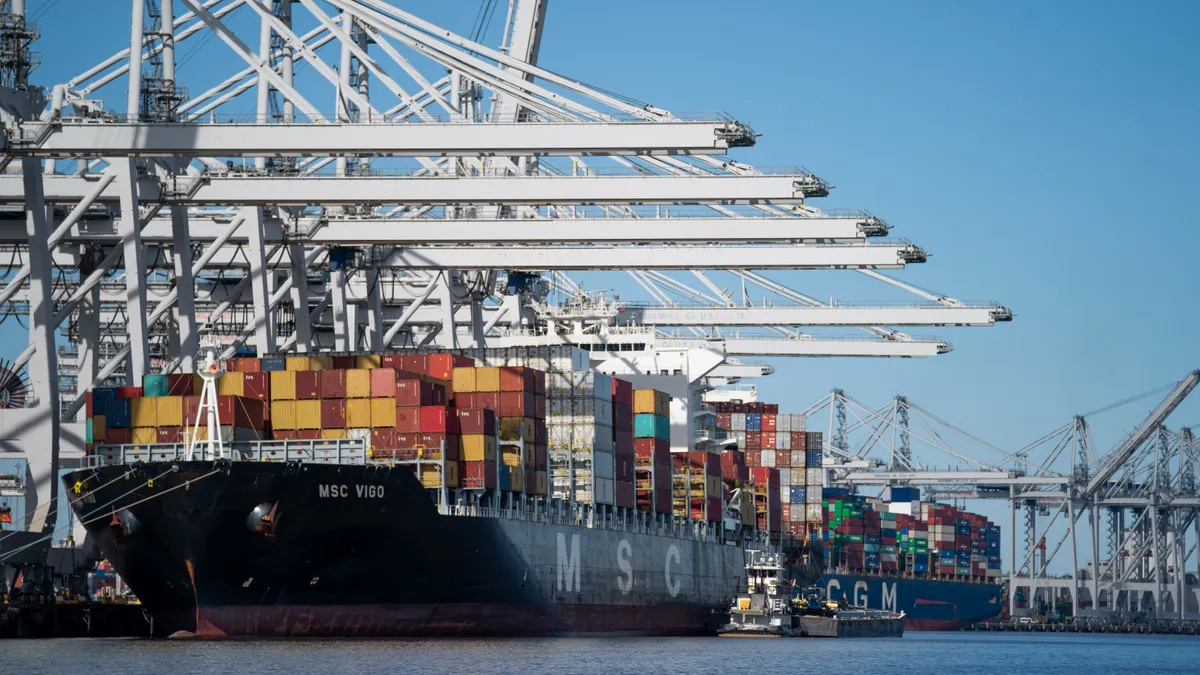Dive Brief:
- Ocean shipping rates are spiking in certain lanes as attacks in the Red Sea lead to higher operating costs for carriers, according to Freightos.
- As of Jan. 3, rates from Asia to Northern Europe rose 151% week-over-week to more than $4,000 per forty foot equivalent unit. Similarly, Asia to the U.S. West Coast grew 63% to $2,713 per forty-foot equivalent unit, which Freightos said may reflect a shift to the West Coast to avoid East Coast transit times.
- Carriers have also announced surcharges of $500 to $2,700 per container. Surcharges for all Asia to North America shipments will start mid-January.
Shipping costs rise in major trade lanes
Dive Insight:
The ongoing attacks in the Red Sea led carriers to reroute their vessels, prompting longer transit times and significantly raising operational costs as they are forced to reroute via the Cape of Good Hope or other lanes.
Around 15% of trade is estimated to move through the Suez Canal, including 8% of grain shipments. Agriculture companies and other exporters have also relied more on the Suez Canal in recent months to mitigate disruptions from a drought-stricken Panama Canal.
When compared to pre-diversion announcements, rates from Asia to the U.S. East Coast had climbed 52% to $3,900 per FEU by Jan. 3, according to Freightos. Meanwhile, rates from Asia to the Mediterranean had more than doubled since January 2019, with CMA CGM announcing that rates on this tradelane will increase to more than $6,000/FEU starting Jan. 15.
However, several sources said that contrary to what shippers saw during the pandemic, carriers now have the capacity to manage the disruption — which may help manage the rate spikes.
While freight rates may increase in the short to mid-term, the trend is not expected to last due to an imbalance in supply and demand and no major sign of a revival, according to a January 2024 Container Market Forecast published by Container xChange, which compiled outlooks from shipping professionals surveyed in December 2023.
The “key question for the industry is the duration of the current situation,” Container xChange CEO and co-founder Christian Roeloffs stated in a Dec. 20 Red Sea analysis.
Daniel Munch, an economist with the American Farm Bureau Federation, said Jan. 9 that farmers will begin to see impacts if attacks continue.
“We are already seeing that surcharges have been added onto a lot of ag exporters already without a 30 day notice which is actually mandated by the Federal Maritime Commission, so it won't be long until farmers who have exported goods to those regions may feel a pinch,” Munch said on a Farm Bureau podcast.
Attacks on commercial vessels continued last week. One attack involved an anti-ship ballistic missile fired against, and potentially the attempted hijacking, of a Maersk ship, a senior administration official in the U.S. told the press in a call.
The event marked "the first time anti-ship ballistic missiles have been used anywhere, let alone against commercial ships," according to the official.
Maersk was one of the two carriers that had earlier announced plans to continue traversing the Suez Canal, with military protection. Now, the carrier — like others — is once again diverting vessels from the Red Sea.
Sarah Zimmerman contributed to this story












